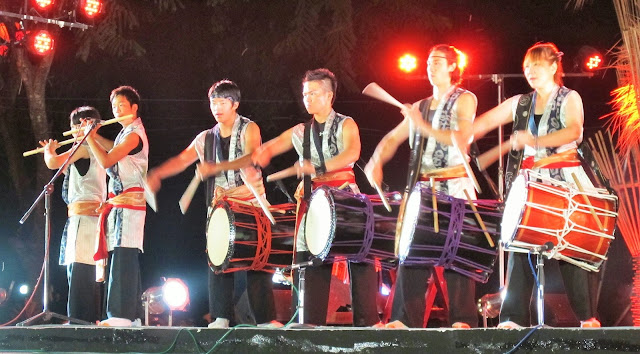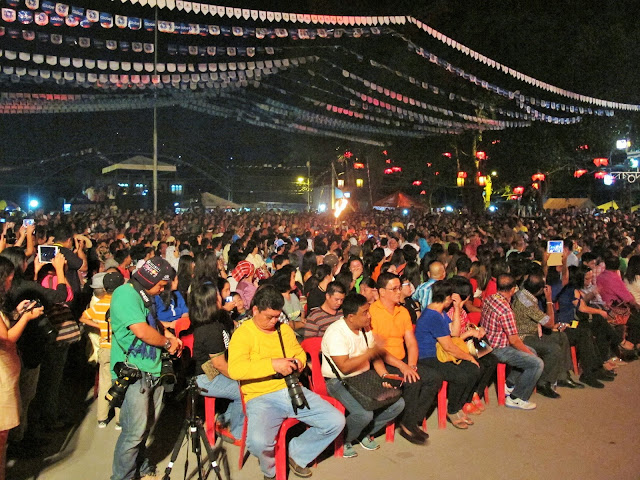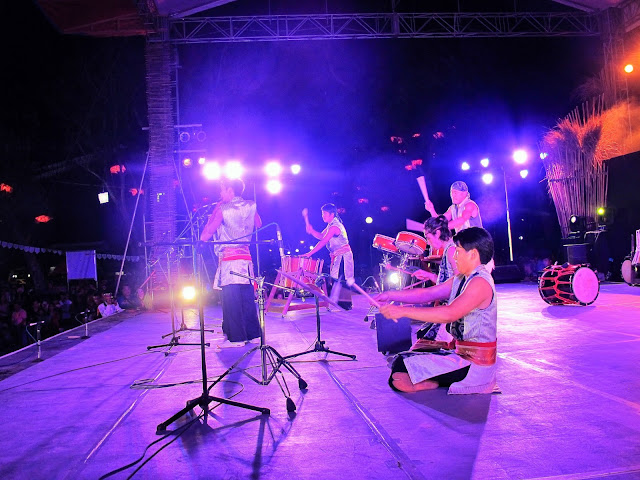 |
| The UP Filipiniana Dance Troupe |
At the Rizal Park of Koronadal
City in southern Mindanao, the Japanese drum ensemble Super Taiko Junior took
the stage. With their taikos, they rumbled like thunder, powerful enough
to still the audience and shake the leaves of the surrounding trees where the
night had taken refuge. And then it rained, but the people did not move from
their places.
The drummers’ following
number was led by a flute, which pierced the air, counterbalanced by slow and
mesmerizing drumming. The strong wind was lulled into a breeze and the rain
tamed into the softest of drizzles until it was gone. Their program was the
most exhilarating, ending with the crowd instantly becoming fans, and people
talked about how the Japanese drummers soothed the weather the following day.
Taiko drumming was initially
used to motivate warriors and instill fear in enemies hundreds of years ago,
and now it is capturing hearts, especially in the South Cotabato capital where
Super Taiko Junior was one of the several international folkloric performing
groups gathered for the Pyesta Kolon Datal: The Koronadal International
Folklore Festival.
The festival was an official
event of the Conseil international des organisations de festivals de folklore
et d’arts traditionnels or International Council of Organizations of Folklore
Festivals and Folk Art (CIOFF), an international nongovernmental organization
that focuses on preserving and promoting traditional arts and culture.
In official partnership with
the United Nations Educational, Scientific and Cultural Organization (UNESCO),
it is accredited to provide advisory service to the Committee of the UNESCO
Convention for the Safeguarding of Intangible Cultural Heritage.
Aside from celebrating the
world’s folkloric art forms, Pyesta Kolon Datal also commemorated CIOFF’s 45th
anniversary and UNESCO’s 70th anniversary. For a big, international gathering
like this, which CIOFF was holding for the first time in the Philippines, why
hold it in Koronadal City, a remotely southern venue, and not in the capital
Manila or any of the more known cities in the country?
The incidence owes to the
bravado of Koronadal City mayor, Dr. Peter Miguel. In October 2014, Miguel
found himself flying to Germany to attend the 44th CIOFF World Congress without
knowing fully what it was all about, he jocularly related. He was made to speak
in front of international delegates and what he emphasized was his invitation
to come to his city. There was much enthusiasm, he recalled, and immediately a
festival to be held in the Philippines was hatched.
“It was putting the cart
before the horse,” described Miguel. They were given a certificate of being an
associate member to be able to host a festival even before they could from an
organization for CIOFF membership.
The Philippines has been a
member of CIOFF, represented by the Cultural Center of the Philippines (CCP)
through Corazon Ynigo, but they have been inactive for about 20 years. Leticia
Wheeler, founder of Filipiniana Dance Company of Montreal, Canada, was asked to
help reactivate the Philippine membership. She was able to meet in 2010
choreographer and dance company founder Edwin Duero, whom she asked for
assistance. Duero then searched for interested parties and suggested in late
2011 that the city of Koronadal is interested in hosting a folklore festival,
leading to Miguel delivering a speech at the CIOFF plenary. Despite being
suddenly thrust into the CIOFF affair, Miguel was fully committed to hosting
the event.
“I was looking at how to
position Koronadal among the top festivals of the Philippines. We know about
the Sinulog, the Dinagyang and the Masskara. Our festival will not get
attention,” he admitted. Korondal City holds the Hinugyaw Festival every
January. He thought hosting an international festival would put the spotlight
on his city.
The festival was set from
August 9 to 18, 2015, in time for Koronadal’s foundation anniversary on Aug.
18. With less than a year to go, Koronadal sought the help of the CCP, which
provided free trainings on festival management. Duero was appointed festival
consultant, and committees were created to oversee the festival.
Koronadal City chose the
Blaan phrase “kolon datal,” literally meaning “a plain of cogon grass,”
from which the city got its name, to be the name of the festival. This was a
way to give importance to the early settlers of the city, the Blaan. The
present major ethnic groups of the city are the Hiligaynon, Cebuano and
Ilocano, a result of later migrations.
The Pyesta Kolon Datal drew
nine delegations from different countries-Ozara Kranj from Slovenia, Ranranga
Dance Academy of Sri Lanka, Folkloric Ballet of the State of Mexico,
Wielkopolanie of Poland, Super Taiko Junior from Japan, IOV Indonesia Youth
Section, the Lang Yan Dancers of Taiwan, Pendik Halk Danslan Tolulugu of Turkey
and the Eline-Kitila Folk Dance Ensemble from Russia.
Miguel recommended seeing the
Russian delegates and their performances. It is not the Caucasian Russians that
we usually know, he said. Indeed, the group is Yakuts from the republic of
Yakutia, or the Sakh Republic, in the far eastern part of Russia. The Yakuts
look very Asian, more like Chinese or Korean, with a dash of Eskimo, Central
Asian and Mongolian. Theirs was, perhaps, the strangest performance of all,
with a mystical quality, flowing white costumes and music from the jaw harp. They
also demonstrated children’s games as a dance routine.
Other groups were also worth
watching. The all-girl IOV Indonesia Youth Section showed how diverse Indonesia
can be and their performances can be mesmerizingly quick-paced and dramatic.
The Ranranga Dance Academy of
Sri Lanka surprised with fire breathing, and the Folkloric Ballet of the State
of Mexico drew from its Aztec roots to come up with a folkloric ballet on love
and regret.
These international groups
were joined by several Filipino cultural performance groups, mostly based in
schools. From Metro Manila were the University of the Philippines Filipiniana
Dance Troupe, Philippine Normal University’s Kislap Sining Dance Troupe and
Barangay Folk Dance Group; from the Visayas, the ECD Dance Company of the
Philippines; and from Mindanao, the Zamboanga del Sur National High School
Melengas Dance Ensemble, the Bukidnon State University Dance Troupe, Koronadal
City’s own Hinugyaw Cultural Dance Troupe and a group of Blaans.
The international folklore festival
was transformed to be like a Philippine contemporary festival with the
de-rigeuer features such as a street dance parade on the opening; a trade fair
showcasing products of the different barangays; concerts by Lolita
Carbon, Joey Ayala and Datu Khomeini Camsa Bansuan, said to be the “King of
Moro Songs;” and a temporary night strip along Alunan Street where bars and
restaurants set up their stalls, a small stage was set up for nightly live
entertainment, and the portion of the street was closed off to traffic.
The main meat of the festival
though was the two-hour performances, twice daily-matinee shows at the South
Cotabato Gymnasium and Cultural Center and gala shows at the Rizal Park.
Several pocket performances were also held at the city’s other public places-
at the KCC Mall of Marbel, Gaisano Grand Mall, Ace Centerpoint and the
Koronadal City Public Market.
Participants traveled to
nearby towns and cities to perform, conduct lecture-demonstrations and interact
with the locals such as in the regional hub of General Santos City, Tacurong
City, Surallah, Isulan in Sultan Kudarat, the barangay of San Jose,
Tampakan, Norala, Tantangan, T’boli, Alabel in Sarangani, Santo Nino, Banga and
Tupi.
All participants visited the
predominantly Blaan villages in the leafy sitio of Nga’bango in the
barangay of Saravia in Koronadal City to interact with the indigenous group and
plant trees. There are 11 Blaan communities among the 27 barangays of
the city. The communities in Nga’bango and in the barangay of Assumption
are recommended if one is to observe traditional Blaan culture. In Nga’bango,
the Blaan still engage in traditional crafts such as hand weaving, wood carving
and basket making. They also perform traditional songs and dances.
With the help of the Hinugyaw
Cultural Dance Troupe, the Blaan of Nga’bango staged dances, based on their
rituals, for Pyesta Kolon Datal. Blaan culture was the main showcase of the
festival on Aug. 18.
“Pyesta Kolon Datal
highlights the unique and distinct culture of our indigenous people, the
Blaans, and we want to share this with the world,” Miguel said.
Their Hinugyaw Festival may
have been eclipsed by other festivals in the country, but through the Pyesta
Kolon Datal, Koronadal City discovered what makes their city unique and it has
been there ever since. May Koronadal continue to celebrate the different indigenous
cultures and peoples—the Blaan, Tiboli, Hiligaynon, Ilocano, Cebuano, etc.—that
made the city their home and continue to imbue it with colors.
 |
| The IOV Indonesia Youth Section |
 |
| The UP Filipiniana Dance Troupe |
 |
| The Folkloric Ballet of the State of Mexico |
 |
| The Ranranga Dance Academy of Sri Lanka |
 |
| The Super Taiko Junior of Japan |
 |
| The Blaan group |
 |
| The Eline-Kitila Folk Dance Ensemble from Russia |
 |
| The street bars |
 |
| The trade fair |
All photos by Roel Hoang Manipon












































































































No comments:
Post a Comment